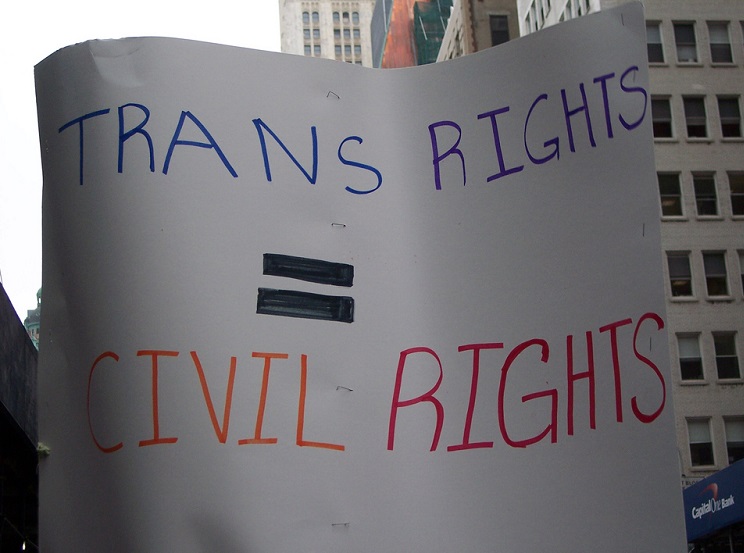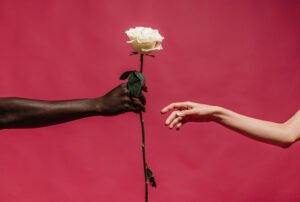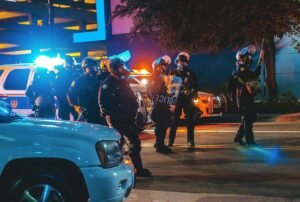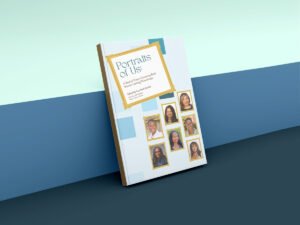
This piece is part of our ongoing Equity, Diversity, and Inclusion (EDI) Project created to spotlight millennials’ voices and thoughts on diversity and justice. We urge you to read how this project came together in collaboration between NPQ and the Young Nonprofit Professionals Network and about the ideology behind this series. We intend to publish another 21 pieces in the upcoming months. Readers will be able to subscribe to an RSS feed to follow articles as they are published, approximately every two weeks. NPQ and YNPN will be using the hashtag #EDISeries, so post about the series along with us.
To stay informed of the project, we also encourage readers to sign up for our daily newsletter, on the right side of this page. If you have any questions or would like more information about the EDI Project, please e-mail [email protected].
Public conversation about transgender people and their rights has come a long way. A quick look at television, mainstream magazines, and social media reveals the huge cultural shift that is taking place. According to Amazon, Transparent was the most binge-watched television series in its Prime Instant Video history. People around the country—straight, LGBTQI, and others—cheered Caitlyn Jenner after her big splash in Vanity Fair, and educated those slinging hate speech her way; and the world has made room for Laverne Cox of Orange Is the New Black and writer and transgender rights activist Janet Mock to be recognized as the fierce and outspoken role models they are.
Yet, when activist Jennicet Gutiérrez raised her voice at the White House in June 2015, demanding that President Obama end the deportations of trans women and address the disproportionate violence inflicted upon them in immigration detention centers, her action was met with animosity. Jennicet was escorted out of the room to a chorus of shushing and booing from LGBT rights advocates, along with President Obama’s clear words: “You’re in my house” and “Shame on ya.”
How can we reconcile the mainstream media celebration of trans identity with the stark reality of violence and injustice that trans women of color, in particular, continue to face today? Has much changed since 1973, when Sylvia Rivera faced intense disrespect at a New York City Pride rally in Washington Square Park? Archival footage shows a young Sylvia standing onstage, pleading to her gay and lesbian brothers and sisters to take political action on behalf of trans people, amid booing and cursing from the crowd. She was able to get out her call to action in the end, and even inspired the crowd to chant “gay power!” along with her, but not before being almost drowned out by a hostile group reminiscent of the one that tried to shame Gutiérrez over forty years later.
Today, the lived realities of low-income and trans people of color remain trapped in the cycles of poverty and violence that trailblazer activists Sylvia Rivera and Marsha P. Johnson fought so hard to end in the 1960s and 1970s. What can we still learn today from Sylvia, Marsha, and the trans women of color who fought alongside them toward uprooting the violence, police profiling, racism, homelessness, and poverty they experienced firsthand? We must ask ourselves, throughout history and up to the present day, who is lifted up in national attention to trans people? Who is furtively erased from the conversation?
Trans inclusion is not as simple as letting go of hurtful stereotypes. It is not as easy as featuring a handful of trans role models in the media and celebrating their visibility. True inclusion is the act of pushing at the tipping point of elevated awareness to tackle the multiple and complicated ways that trans communities are marginalized in society. Trans inclusion needs movements to engage interconnected justice frameworks to address the deepest forms of inequity. True inclusion comes from movements that explicitly dismantle the interrelated harms of gender discrimination, sexism, economic barriers, violence, and other systemic abuses that compound one another, leaving trans people perpetually at the margins of society.
There are powerful examples of trans inclusion in racial justice, immigrant justice, and feminist and reproductive rights movements that exemplify the catalytic power of centering those at the margins. Across a wide range of missions, movement-building efforts have become more inclusive of trans leaders, and this has led to an important realignment of strategies that address the complex needs of trans people—particularly trans women of color, who disproportionately suffer from the violence and inequality leveled at the LGBTQI community.
These shifts in organizing are teaching us to be trans inclusive, but not just because it’s the right thing to do or because it is a trending topic. We are learning that when we connect the silos of racial justice, economic justice, health justice, immigration justice, and civil rights, we are closer to ending marginalization and oppression. Inclusive approaches are a practice—not just an idea—of destigmatization and empowerment that makes it clear that we are all better off when we focus on advancing the needs and leadership of communities that are most marginalized.
What Is Marginalization? Why Start There?
The story of oppressed communities making gains in the United States is often told through the lens of the civil rights struggle. Looking at legal and civil rights as tools for change is essential, but this rarely tells the full story of what it takes to end marginalization and inequality. There is no doubt that transgender communities in the United States lack civil rights, but rights and reality are often miles apart.
The lens of marginalization is useful in addressing how transgender people experience inequality, violence, and oppression even as their legal status and legal rights change or advance. Marginalization refers to a lack of representation in society, cultural stigma, limited employment options, increased rates of homelessness, incarceration, experiences of physical violence, and lower life expectancy. Uprooting these systemic harms requires an understanding of oppression that looks beyond changing laws and toward inspiring seismic shifts in culture, systems, representations, and societal attitudes.
Nothing better exemplifies the dual marginalization and civil rights crisis faced by transgender people than the increasing epidemic of transphobic murders. Over the last seven years, more than 1,700 transgender people have been murdered worldwide.1 Despite national advancements in transgender visibility and legal rights, murder rates in the United States have been surging. The average life span of trans women of color is thirty-five years.2 In 2015 alone, there were twenty-three known killings of transgender people—and this statistic does not account for unreported murders.3
It is crucial to consider who is being targeted. Among LGBTQI people in the United States, transgender women and transgender women of color are the most targeted by hate violence.4 In the first two months of 2015, transgender women of color in the United States were being murdered at a rate of almost one per week.5 The National Coalition of Anti-Violence programs reports that “72% of hate crimes against LGBTQ people were against trans women, 90% of whom were transgender women of color.”6
Extraordinarily high murder rates certainly expose trans marginalization, but it is equally telling that state and national bodies fail to address these murders. Killings of trans people often go uninvestigated, and perpetrators frequently get lenient treatment. In trials, “gay panic” or “trans panic” defenses are customarily used to argue that the shock and fear of discovering that someone is transgender or intersex lawfully excuses the act of killing them. Only in 2014 did California become the first and only state to ban the use of this defense.
Beyond murders, a look at who is most marginalized within transgender communities paints a vivid and chilling picture of inequality in America today. Zoom into any one issue facing transgender people—employment, healthcare, education, housing—and you see tremendous disparities related to gender, race, immigration status, and class. From a legal rights perspective, transgender communities are one entity, so legal rights solutions often fail to explicitly dismantle harms faced by low-income transgender women and transgender women of color.
To bring the most marginalized members of our trans communities into focus, we must examine the ways oppressions and structural barriers multiply, compound each other, and magnify existing challenges. Using multiple lenses to understand inequity can help build root-cause solutions. This includes weaving together trans-justice solutions with racial justice, immigration justice, feminism, and economic justice, for example.
From Push Out to Inclusion
Against all odds—facing a lack of institutional power, blocked access to philanthropy, and a long legacy of exclusion from social justice movements—transgender communities have a long history of resistance.
Transgender people have been organizing for change long before the “T” was reluctantly added to “LGB.” It is widely recognized that transgender women of color—including Marsha P. Johnson and Sylvia Rivera—were the first to resist the Stonewall police raid in 1969, catalyzing the early days of what we now know as the LGBTQI movement.
Despite Marsha P. Johnson and Sylvia Rivera’s brave resistance to police violence, the emergent gay liberation movement wanted nothing to do with them, and it literally pushed transgender people out of its vision of liberation. Trans sisters of color were quickly erased from history, as was their inclusive vision of liberating all LGBTQI people from poverty, homelessness, racism, sexism, police violence, hate crime murders, and the mental illnesses caused by stigmatization and discrimination. These women were marginalized by society at large, only to then be sidelined again by the gay liberation movement. The indelible consequences of their double-edged marginalization continue to impact trans people of color today.
Exclusion of transgender people from the gay liberation movement and from later social movements barred their access to civil rights, institutional power, and economic resources, including the funding streams that now power LGBTQI organizations. According to Funders for LGBTQ Issues, .015 percent—or a mere one penny for every one hundred dollars—of philanthropic spending went to transgender issues between 2005 and 2015.
Despite the exclusion that transgender people faced during the waves of activism since the 1960s, transgender people managed to organize—often with very little or no funding and support. While many people assume that the transgender movement is new or came after the gay movement, in 1970, one year after the Stonewall riots, Marsha and Sylvia cofounded Street Transvestite Action Revolutionaries (STAR), later named Street Transgender Action Revolutionaries—which was led by and for transgender people.7 STAR advocated for homeless drag queens, transvestites, and runaway queer youth, and eventually created a shelter to provide the community with housing. Sylvia was representing STAR when she was almost pushed off the stage of the Gay Liberation Rally in 1973. Tragically, Sylvia continued to be pushed to the margins of the movement, and her exclusion can be seen as much as a rejection of her as a transgender person as it was a rejection of her political analysis and her belief that gay liberation should center on the needs of people within the community who were homeless, low income, drug users, drag queens, and transvestites.8
Sylvia attempted suicide after the Pride incident in 1973, devastated by being forcibly pushed out of the movement she helped to build.9 After that, STAR more or less stopped functioning. Sylvia Rivera nonetheless continued her commitment to a trans-inclusive LGBTQI movement. She even petitioned the Empire State Pride Agenda for trans inclusion on her deathbed, in 2002.10 That same year, the Sylvia Rivera Law Project (SRLP) was founded in New York City to carry on Rivera’s legacy.11
STAR’s leaders did not want transgender people merely included in mainstream gay organizations. Their vision was for a movement with diverse leadership and core values of anti-oppression. This tension lives on today. Beyond token representation, anti-oppression work stems from seeing the communities who are the worst off as the natural leaders of justice movements. Sylvia was pushed out of the Gay Liberation Movement because she was seen to represent the most marginal of the marginalized. Many LGB organizations treated trans rights as something to get to, but only after gay and lesbian rights were won. The project of trans inclusion calls for a paradigm shift toward understanding social issues from the perspective of the communities that bear the brunt of their impact.
Case Studies of Transgender Leadership and Inclusion within Social Movements
There is much to be said for the vital work of trans-autonomous movements pushing for the rights, inclusion, and equity of trans people. Here, we will focus on the rich history of trans inclusion work driven by LGBTQI, feminist, racial justice, and immigrant justice organizations. Vibrant recent examples include Black Lives Matter, immigrant rights, and reproductive justice organizers, who are, for the first time, attempting to incorporate the challenges of trans people and uplift trans leadership.
While still works in progress, these movements attempt to steer clear of tokenization and shallow acknowledgment of trans struggles. Instead, they highlight how trans people are targeted by police, are subject to state violence, and face poverty, barriers to reproductive health, and a multitude of other injustices.
Trans-Inclusive Racial Justice Organizations
A strong, recent wave of trans-inclusive racial justice organizing has stemmed from visionary young Black leaders, many of whom are queer and trans, who are creating a new model of Black liberation premised on leaving no one behind. The three founders of Black Lives Matter—Alicia Garza, Opal Tometi, and Patrisse Cullors, all black women, two queer—set the tone for inclusivity through their committed vision that all Black lives matter. This belief has spurred a historically unprecedented trans-inclusive national movement for racial justice.
The strong ties between national racial justice and LGBTQI movement building became widely visible with a 2010 report by Race Forward: The Center for Racial Justice Innovation, titled “Better Together: Research Findings on the Relationship Between Racial Justice Organizations and LGBT Communities,” which shed light on ongoing movement building between organizers working against racism and toward LGBTQI rights. Two years later came a report titled “Better Together in Action: Organizations Working to Integrate Racial Justice and LGBT Issues,” which offered models for integrative organizing based on case studies of several organizations.12
Sign up for our free newsletters
Subscribe to NPQ's newsletters to have our top stories delivered directly to your inbox.
By signing up, you agree to our privacy policy and terms of use, and to receive messages from NPQ and our partners.
Just a few weeks later, the Black Lives Matter movement emerged around the acquittal of George Zimmerman for the murder of Trayvon Martin, and rocked the country, breaking national silence around anti-Black state violence. Included in the Black Lives Matter network are many new racial justice organizations that boldly analyze how police and state violence specifically impact queer and transgender Black Americans.
When news broke in August 2015 of the discovery of three murdered trans women of color within a twenty-four-hour period,13 Black Lives Matter declared August 25th Trans Liberation Tuesday, and responsive actions sprouted up across the country in twenty different cities.
Black transgender organizer Elle Hearns, a leader at Get Equal and Black Lives Matter, attests to the urgency of amplifying news of transphobic anti-Black violence amid the national conversation about Black boys and men being killed at the hands of police. At a rally in Washington, D.C., Hearns said, “When you talk about ‘Black Lives Matter,’ you do not think of Black trans people. You do not think of the Black trans women who are being murdered….We learned about the murders of five [sic] Black trans women in one day. And there was no outrage. There was no shutting down in the streets.”14
The commitment to trans inclusivity by Black Lives Matter leaders is, in fact, undoubtedly clear, even as national conversation lags. Black Lives Matter cofounder Garza makes the widely inclusive framework explicit when she says, “Black Lives Matter affirms the lives of Black queer and trans folks, disabled folks, black [sic]-undocumented folks, folks with records, women and all Black lives along the gender spectrum.” Beyond simple affirmation, Garza names the centering of these marginalized groups as “a tactic to (re)build the Black liberation movement” where it formerly left them out.15
Another prime example of trans-inclusive racial justice organizing is the young-people-led, member-based organization Black Youth Project 100 (BYP100), founded in 2013. BYP100 has shed crucial light on how Black women, cisgender and transgender, are targeted by police violence. BYP100’s #SayHerName campaign, launched in 2015, has been a beacon of Black trans- and cis-women-focused antiviolence organizing.16 The campaign drew Black women to the streets in protest, breaking open conversation about police killings of Black cis and trans women at a time when national focus remained centered on young Black men and boys.
In May of 2015, the African American Policy Forum, the Center for Intersectionality and Social Policy Studies at Columbia Law School, and Soros Justice Fellow Andrea Ritchie published a report (updated in July 2015) to raise awareness about police violence against Black women. The report, titled “Say Her Name: Resisting Police Brutality Against Black Women,” sets forth a clear trans-inclusive mission, stating, “The frameworks and stories presented in ‘Say Her Name’ point to specific actions community organizers, policy makers, researchers, and the media can take to build a comprehensive approach to fighting state-sanctioned violence—one that is inclusive of non-transgender, transgender, and gender-nonconforming Black women.”17
National Director of BYP100 Charlene Carruthers made the commitment to queer and trans safety clear when she stated in an interview, “This is about centering the narrative and political demands around black women and girls, making sure we lift up black queer and transgender people.”18
Similarly, civic engagement organization Rise Up Georgia works to empower what organizers call “the new majority—which includes people of color, women, the LGBTQ community, working people, immigrants, and young people.”19 Rise Up Georgia, founded in 2014, foregrounds participatory democracy that advances racial and economic justice on a pillar of inclusion. Their model of representation spans a wide cross section of communities most disproportionately impacted by civic exclusion.
While there is certainly a long way to go in terms of full adoption of gender justice and trans justice within national racial justice organizing, these recent shifts toward inclusion are incredibly significant and worthy of deep inquiry.
Mark-Anthony Johnson, a respected civil rights leader and community organizer, remarks on the importance of the Black Lives Matter founders’ visionary approach, saying, “The character of the folks that [Black Lives Matter was] bringing out I think was really important in terms of having a group that was significantly women, significantly queer, having Black transgender people in the space. And that’s possible because of them and the national team that they built up around them.”20
In his report for The Nation on the three-day July 2015 Movement for Black Lives gathering at Cleveland State University, nationally recognized civil rights activist, journalist, and thought leader Mark Winston Griffith wrote of the Black Lives Matter movement that the “most significant break from the black political status quo was the space claimed by queer, transgender, and gender-nonconforming attendees.”21
Trans-Inclusive Immigrant Rights Movement
The day after Jennicet Gutiérrez interrupted President Obama at the White House’s Pride Month Celebration, White House press secretary Josh Earnest said he wasn’t aware if President Obama knows of any mistreatment that transgender immigrants experience while in detention. Immediately after, thirty-five members of Congress issued a letter to the head of Department of Homeland Security, Jeh Johnson, calling for an end to “LGBT” detentions. That same week, U.S. Immigration and Customs Enforcement (ICE) released a memo stating that the detainees would now be detained in gendered facilities according to the detainee’s gender identity.
This measure is incomplete and doesn’t address the root causes of detention conditions in the first place—yet, it is a victory. It signals the growing power of an increasingly trans-inclusive immigrant rights movement and likewise the strong commitment of LGBTQI organizations to immigration justice.
Trans leaders have served as powerhouses of immigrant rights organizing, bringing the harsh violence that undocumented trans and queer immigrants face to national attention. Immigration poses particular challenges to trans and LGB communities, as many come to the United States to seek asylum from hate violence in their countries of origin. Trans immigrants experience extreme forms of violence in U.S. detention centers. While “only 1 in 500 detainees identifies as trans, a staggering 1 in 5 victims of sexual abuse in immigration detention is trans.”22
As a result, the immigration and Latino/a rights movement meaningfully practices trans inclusion. The National Latina Institute for Reproductive Health (NLIRH) is one of the only organizations representing Latina women and reproductive rights issues among the more large, powerful, and male-dominated immigration organizations. While taking a stance on trans inclusion and LGBTQ Latino/a rights could pose a risk for NLIRH, they took an advocacy position to include the needs of trans communities in their work. In the wake of the 2015 Supreme Court decision granting marriage equality to same-sex couples, NLIRH’s executive director Jessica González-Rojas released a statement saying, “Even as we celebrate this step forward, queer and transgender immigrants are being held in detention centers where they are subjected to isolation, assault, and the denial of healthcare; LGBTQ youth face higher rates of homelessness; and transgender women experience unconscionable violence, including at the hands of police.”23 This solidarity indicates the significant shift in elevating transgender immigration justice.
There has also been a rise in LGB and trans-specific immigration organizations that engage in service provision as well as grassroots organizing and leadership development. Immigration Equality, for example, was founded in 1994 to provide free legal services to LGBTQ and HIV-positive immigrants.24 Trans-specific organizations have also proliferated in the last ten years, and a significant portion, including the two largest, has engaged in immigration rights organizing and advocacy. In March of 2015, the Transgender Law Center, one of the largest trans-specific organizations in the United States, released a “Statement of U.S. Transgender Organizations on Immigration Reform.” The statement was signed by thirty-one trans-led organizations, and stated that “any vision of Comprehensive Immigration Reform…must include ensuring security and safety for trans immigrants.”25 Not long ago, thirty-one trans-specific organizations did not even exist.
The DREAMer Movement stands out as a broad grassroots immigration reform effort that prioritizes leadership and experiences of LGBQ, trans, and intersex undocumented immigrants. The DREAMer Movement originated in the mid-2000s with promotion of The Development, Relief, and Education for Alien Minors (DREAM) Act, which “would provide a path to citizenship for immigrant youth brought to the U.S. as children.”26 While the act did not pass, an empowered group of undocumented youth grew a forceful movement that eventually became the organization United We Dream (UWD), in 2008. The DREAMer movement includes many queer and transgender youth who coined terms like UndocuQueer and play significant roles as movement leaders. LGBTQ youth leadership is exemplified in Queer Undocumented Immigrant Project (QUIP), which formed “to transform the immigrant and LGBTQ movements, to adopt an intersectional analysis in their efforts to advance and build power for the rights of both communities.”27 Embodied in this mission is a clear desire to organize from a space of holding multiple identities, to fully belong without leaving the broader immigrant rights community.
Feminist and Reproductive Justice Movements
Trans inclusion within the women’s and reproductive rights and justice movements has been fraught. There has been much media coverage that focuses on trans exclusion within the women’s movement, including Elinor Burkett’s New York Times article, “What Makes a Woman?” and Michelle Goldberg’s New Yorker article, “What Is a Woman?”28 Both articles use the transgender tipping point to give new traction to trans-exclusionary thinking within feminism. What is perhaps more significant is how the media fixated on these old-school ideas while ignoring the newsworthy trend that speaks to more intentional trans inclusion within women’s and reproductive justice organizations.
While philanthropy can be slow to adjust to new trends in social movements, there have been promising developments of LGBQ and trans inclusion in a number of reproductive-justice and women-focused funders. In fact, the New York Women’s foundation is the tenth largest funder of trans-led organizations in the United States.29 Women’s, feminist, and reproductive-justice foundations are slowly but surely moving resources to trans-led organizations, and are changing their missions to include LGBQ and transgender communities. The earliest feminist foundation to do so in the United States is the Third Wave Fund (formerly named Third Wave Foundation, and earlier, Third Wave Direct Action Corporation).
Third Wave Fund began the process of becoming a trans-inclusive feminist organization in 2001, years before transgender was added to many LGB organization missions, and well before other feminist or women’s foundations. However, Third Wave, though founded with queer and straight feminist leaders, had not been trans inclusive from the start. The mission was officially changed to specifically mention transgender people in 2003, and now Third Wave’s board is 30 percent transgender and gender nonconforming. The coauthor of this article, Rye Young, is their first trans executive director, and he is one of the only (if not the only) public trans leader in women’s philanthropy in the nation (if not the world). In the years following Third Wave’s change, a handful of foundations whose prior mission statements only spoke of women now serve transgender people, including Foundation for a Just Society and the Groundswell Fund. Furthering this trend, in fall of 2015, in a public-facing campaign, the Ms. Foundation reframed its definition of feminism to include “the social, economic and political equality of ALL genders.”30
Many reproductive health organizations have tackled barriers to access, including gender and trans discrimination, through a reproductive-justice framework. Specifically, many have addressed the barriers trans people face in healthcare institutions, in order to expand and reframe practices to serve trans peoples’ medical and legal needs.
Atlanta’s Feminist Women’s Health Center (FWHC)—known for providing abortion and other women’s health services—began a sliding-scale Transgender Health Initiative in 2000. The initiative provides obstetrics and gynecology care for transgender people. FWHC’s holistic health services reach beyond direct health services, including providing legal support such as letters for transgender people to process name changes and access insurance coverage.
Also in Atlanta, SPARK Reproductive Justice NOW provides an important example of how expanding a mission from a focus on pro-choice activism to a broader set of reproductive justice issues opens the door to trans inclusion. Originally Georgians for Choice, SPARK began as a coalition with a single-issue focus: “attaining and protecting reproductive freedom.” It later grew into an organization with a multi-issue vision, committed to serving transgender communities. SPARK’s expansive and transformative mission is to “build new leadership, change culture, and advance knowledge in Georgia and the South to ensure individuals and communities have resources and power to make sustainable and liberatory decisions about our bodies, gender, sexualities, and lives.” SPARK has become a center that is focused on both reproductive justice and LGBTQ issues. They run an LGBTQ youth of color media camp and provide services such as information on how transgender people can change their names and pronouns in Georgia—all under the banner of reproductive justice.
Even when abortion remains the focal point, there has been a significant increase in organizations that seek to include trans and gender-nonconforming people. One clear way that this is happening is through the rise of gender-inclusive language, which means framing abortion-rights language in a way that does not assume that the gender of anyone seeking an abortion is female. For instance, The New York Abortion Access Fund emphasizes the connection between trans and cisgender women’s needs: New York Abortion Access Fund’s belief in one’s right to physical autonomy links the concern for abortion access to the organization’s belief that transgender and gender-nonconforming people should have access to healthcare that is inclusive of abortion. For some a rather radical statement, New York Abortion Access Fund makes its trans-inclusive practices clear, stating, “We recognize that people who identify as men can become pregnant and seek abortions; we strive to meet the needs of all people who seek our funding.”
While not widely known for trans inclusivity, Planned Parenthood provides several health services for transgender people. For many trans people around the country, Planned Parenthood clinics are the only places where they can access hormones. This is true even in states where clinics are under attack, barred from providing abortion care to their clients. Many Planned Parenthood clinics have gender-neutral restrooms to make their offices comfortable for transgender and gender-nonconforming clients.
All of these examples of trans-inclusive movement building reveal the lesser-told story of how trans inclusion allows us to fully see the true nature of social problems. Yet this struggle is ongoing. More must be done to ensure that transgender people are employed to do movement work and are respected in the workplace, and that leadership of the most marginalized among us is centered. We want to celebrate the incremental and significant shifts, while encouraging more people working in civil society and social change organizations to take further steps toward inclusion.
Trans Inclusion Beyond the Media Moment
National interest comes and goes. The current spotlight on trans issues, trans celebrities, and trans characters on television is no exception. It is crucial to widen our lenses to fully understand the contemporary challenges and systemic injustices that trans people face as the national conversation on trans rights explodes. Equally crucial is that we remember that trans justice is a centuries-long fight—and it continues, more dire than ever, as trans peoples’ lives remain on the line in the United States and abroad. Finally, it is necessary to dig deeper to consider communities, movements, and organizations that may not be getting that spotlight but are doing groundbreaking work to end the murders, abuse, and oppression of trans people.
We must remember that visibility comes with backlash. As images of trans people hit the news cycle, our television screens, and our media devices, and as federal hate crime legislation shifts toward protecting trans people, state backlash bills are on the rise. Bathroom bills and other discriminatory laws are rapidly popping up across the country, targeting trans people in more explicit ways than ever. At the time of editing this article, forty-four anti-trans bills propose anti-trans laws across sixteen states.31 This compounds with the existing violence and civil rights limitations that trans people in the United States contend with every day.
In this historic moment, we must uncover the discrepancies between policy, lived experience, and trending or celebrity representation and inclusion. We can all follow the lead of our sisters and brothers fighting to end deportation, police killings, and sexism. We all have a role to play in truly ending the marginalization of trans people.
Notes
- “Alarming Figures: Over 1,700 Trans People Killed in the Last 7 Years,” Transrespect vs. Transphobia, May 8, 2015.
- Michael K. Lavers, “Report: 594 LGBT people murdered in Americas during 15-month period,” Washington Blade, December 20, 2014.
- “Stop Trans Murders,” National LGBT Task Force, October 16, 2015.
- Don Terry, “In the Crosshairs,” SPLC Hatewatch (blog), June 9, 2015.
- Samantha Michaels, “It’s Incredibly Scary to Be a Transgender Woman of Color Right Now,” Mother Jones, last modified July 22, 2015.
- “Stop Trans Murders,” National LGBTQ Task Force, December 2015.
- “Street Transvestite Action Revolutionaries,” Wikipedia.
- Anna Klebine, “‘Hell Hath No Fury like a Drag Queen Scorned’: Sylvia Rivera’s Activism, Resistance, and Resilience,” OutHistory.org.
- Ibid.
- Ibid.
- SRLP “focuses on those in our community who face multiple vectors of state and institutional violence: people of color, incarcerated people, people with disabilities, people with HIV/AIDS, immigrants, homeless people, youth, and people trying to access public benefits.” See “Our Approach and Principles, Approach and Principles of the Sylvia Rivera Law Project (SRLP),” Sylvia Rivera Law Project.
- For downloads, see Race Forward: The Center for Racial Justice Innovation, Research section.
- David Mack, “Three More Transgender Women of Color Killed,” BuzzFeed News, August 15, 2015.
- Rian Brown and Angela Peoples, “We Disrupted Hillary Clinton on Behalf of Black Trans Women—Here’s Why,” GetEqual.org (blog), September 2, 2015.
- Alicia Garza, “A Herstory of the #BlackLivesMatter Movement,” The Feminist Wire, October 7, 2014.
- Cisgender is a term that refers to people who are not trans, as in people whose sex they were assigned at birth more or less aligns with their assigned gender. (This is the most commonly used term, though there has been some pushback against its use, notably by Loretta Ross, a key leader and early originator of the reproductive justice movement, who has pointed out that it is problematic to impose a term that derives from white-dominated medical and academic fields onto women of color. It is far more common, however, to find examples of Black women movement leaders who have embraced the term.)
- Kimberlé Williams Crenshaw and Andrea J. Ritchie with Rachel Anspach, Rachel Gilmer, and Luke Harris, “Say Her Name: Resisting Police Brutality Against Black Women,” African American Policy Forum, July 2015.
- Sarah Lazare, “Under Banner of ‘Black Women and Girls Matter,’ Wave of Protests to Sweep Country,” Common Dreams, May 20, 2015.
- “About,” Rise Up.
- Deron Dalton, “The Three Women Behind the Black Lives Matter Movement,” Madame Noire, May 4, 2015.
- Mark Winston Griffith, “Black Love Matters,” The Nation, July 28, 2015.
- Trans Formational Impact, U.S. Foundation Funding for Trans Communities, Funders for LGBTQ Issues—Special Report, February 2015.
- Loretta Kane, “Latina Advocates Applaud Historic Marriage Equality Decision,” National Latina Institute for Reproductive Health press release, Washington, DC, June 26, 2015.
- “Statement of U.S. Transgender Organizations on Immigration Reform,” Transgender Law Center.
- Ibid.
- “Our History,” United We Dream.
- “QUIP®, QUIP’s Mission,” United We Dream.
- Elinor Burkett, “What Makes a Woman?”, New York Times, Sunday Review, June 6, 2015; Michelle Goldberg, “What Is a Woman?”, New Yorker, August 4, 2014.
- Trans Formational Impact, U.S. Foundation Funding for Trans Communities, Funders for LGBTQ Issues—Special Report, February 2015.
- “Feminism: The Social, Economic and Political Equality of All Genders,” Ms. Foundation for Women.
- Dawn Ennis, “REPORT: 2016 Is the Most Dangerous Year for Transgender Americans,” Advocate, February 22, 2016.









